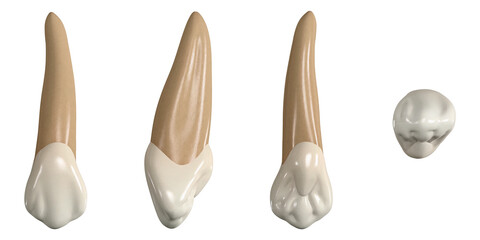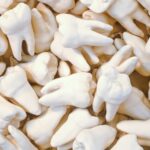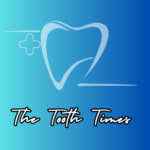Exploring the Maxillary Canine: Anatomy and Functions

Introduction:
The maxillary canine, commonly known as the “eye tooth,” is a vital component of our dental anatomy. Positioned between the lateral incisor and the first premolar, this tooth serves both functional and aesthetic roles. In this article, we will delve into the detailed anatomy of the maxillary canine, exploring its features on the buccal, lingual, distal, mesial, and occlusal aspects, while shedding light on its important functions.
Anatomy:
Buccal Aspect:
The buccal (outer) surface of the maxillary canine features a pronounced cusp called the cingulum. This cusp is centrally located and aids in guiding food during the chewing process. The cingulum is surrounded by a slightly convex surface, making the tooth well-suited for efficient biting and tearing.
Lingual Aspect:
On the lingual (inner) side of the tooth, the cingulum extends as a raised ridge. This ridge acts as a protective barrier for the tooth’s inner structures and also assists in maintaining proper alignment of the teeth.
Distal Aspect:
The distal side of the maxillary canine faces away from the midline of the mouth. It connects the tooth to the adjacent first premolar. This aspect contributes to the overall stability of the dental arch and ensures proper occlusion during biting and chewing.
Mesial Aspect:
The mesial side of the maxillary canine faces toward the midline of the mouth. It is adjacent to the lateral incisor. The mesial aspect plays a role in maintaining proper spacing between teeth, which is essential for a balanced bite.
Occlusal Aspect:
The occlusal (biting) surface of the maxillary canine features a single cusp, which aids specially in efficient cutting and tearing of food. This cusp is strategically positioned to mesh with the corresponding lower tooth, ensuring optimal bite function.
Functions:

Biting and Tearing
The maxillary canine’s robust cusp and sharp edge are designed for efficient cutting and tearing of food. This tooth’s location in the arch allows it to effectively engage with lower teeth during biting, making it crucial for initial food breakdown.
Guiding and Stabilizing:
The cingulum and raised lingual ridge of the maxillary canine assist in guiding food towards the occlusal surfaces of other teeth during chewing. Additionally, its position between the lateral incisor and first premolar helps stabilize the dental arch.
Aesthetic Contribution:
Beyond its functional roles, the maxillary canine also plays a significant aesthetic role. Its strategic location near the front of the mouth means that it contributes to the overall appearance of the smile, adding to a balanced and harmonious look.
Conclusion:
The maxillary canine’s intricate anatomy on the buccal, lingual, distal, mesial, and occlusal aspects underscores its essential functions in biting, tearing, guiding, and stabilizing.
Beyond its functional significance, this tooth also enhances the aesthetics of our smile. Understanding the role of the maxillary canine highlights the remarkable harmony and complexity of our dental architecture, showcasing nature’s meticulous design for optimal function and appearance.
Exploring the Mandibular Canine: Anatomy and Functions

Introduction
The human dentition is a remarkable testament to nature’s intricate design, and within it, each tooth plays a unique role. One such tooth that often takes center stage is the mandibular canine. This essential dental structure boasts a distinct anatomy and a vital role in the overall function of the oral cavity. In this article, we delve into the world of the mandibular canine, exploring its anatomical features and its crucial functions.
Anatomy of the Mandibular Canine
The mandibular canine, commonly known as the lower canine or “eye tooth,” is situated in the anterior region of the mandible, flanked by the incisors and premolars. Its anatomy reveals a fascinating interplay of various surfaces
Buccal Surface
The outer surface of the mandibular canine that faces the cheeks is referred to as the buccal surface. This surface is usually convex and tapers gently from the cervical area towards the incisal edge.
Lingual Surface
The inner surface of the tooth that faces the tongue is known as the lingual surface. It mirrors the buccal surface’s general shape but is often flatter and less pronounced.
Distal Surface
The distal surface of the mandibular canine is located toward the back of the mouth, adjacent to the premolar teeth. It forms a contact area with the adjacent premolar, aiding in proper alignment and occlusion.
Medial Surface
Positioned toward the midline of the oral cavity, the medial surface of the mandibular canine meets the adjacent incisor tooth. This surface aids in maintaining the proper alignment of the teeth and contributes to a harmonious bite.
Occlusal Surface
Unlike molars, canines do not possess a true occlusal surface. Instead, the incisal edge of the mandibular canine serves a functional purpose during biting and cutting food.

Functions of the Mandibular Canine
Cutting and Tearing
The mandibular canines are exceptionally well-suited for cutting and tearing food. Their pointed and sharp incisal edges act like natural scissors, helping in the initial breakdown of food during chewing.
Maintaining Occlusion
The mandibular canines play a pivotal role in ensuring proper occlusion. They guide the upper canines into the correct position during biting and chewing, promoting an even distribution of forces across the dental arch.
Aesthetic Appeal
These teeth also contribute to the aesthetic appearance of the smile. Their strategic placement and shape are essential for a balanced and pleasing smile.
Speech Articulation
Canines, including the mandibular canines, aid in speech articulation by controlling airflow and sound production, especially for certain consonant sounds.
Conclusion
The mandibular canine may be one of the smaller members of the dental family, but its impact on both form and function is substantial. From its distinct anatomical surfaces to its vital functions in cutting, occlusion, aesthetics, and speech, this tooth demonstrates the marvels of nature’s design. As we continue to marvel at the intricacies of the oral cavity, let us not forget to appreciate the role played by the humble mandibular canine in ensuring our dental health and overall well-being.
Frequently Asked Questions (FAQs)
1. What are maxillary and mandibular canines?
Maxillary canines are the pointed teeth located in the upper jaw, while mandibular canines are their counterparts in the lower jaw. They are commonly known as “eye teeth” due to their prominent position and resemblance to the eyes of certain animals.
2. How many maxillary and mandibular canines do we have?
In a complete adult dentition, there are a total of four canines – two maxillary (upper) canines and two mandibular (lower) canines, with one in each quadrant of the mouth.
3. What is the purpose of canines in the mouth?
Canines serve several important functions, including cutting and tearing food during chewing, helping maintain proper occlusion (bite alignment), contributing to the aesthetics of the smile, and aiding in speech articulation.
4. How do maxillary and mandibular canines differ in appearance?
Maxillary canines are typically larger and more robust than mandibular canines. They have a single long root and a more pronounced cusp, which aids in their role of cutting and tearing food. Mandibular canines are slightly smaller and have a more slender appearance.
5. How do canines contribute to a balanced bite?
Canines play a key role in guiding the jaw during biting and chewing. Their precise placement helps prevent excessive wear on other teeth and ensures that the upper and lower teeth come together in a harmonious manner, leading to proper occlusion.
6. Are canines important for speech?
Yes, canines, especially the maxillary ones, contribute to speech articulation. They play a role in controlling airflow and shaping sounds, particularly certain consonant sounds.
7. Do canines have any specific dental problems associated with them?
Canines, like other teeth, can be susceptible to cavities and gum disease if not properly cared for through regular brushing, flossing, and dental check-ups. Additionally, they can experience wear or damage due to grinding or clenching habits.
8. Are maxillary and mandibular canines involved in orthodontic treatment?
Yes, canines are frequently involved in orthodontic treatment plans. They play a crucial role in achieving proper bite alignment and may require braces or other orthodontic appliances to ensure they are positioned correctly.
9. How can I keep my maxillary and mandibular canines healthy?
Maintain a consistent oral hygiene routine, including brushing, flossing, and using mouthwash. Regular dental check-ups are important for early detection and treatment of any dental issues. Avoid habits like nail biting or using your teeth to open packages, as these can lead to damage.
10. Can canines be replaced if they are lost?
In the case of tooth loss, canines can be replaced with dental prosthetics such as dental implants, bridges, or partial dentures. However, preserving natural teeth through good oral hygiene practices is always preferable.
Remember that each tooth, including maxillary and mandibular canines, plays a unique and essential role in maintaining overall oral health and function. If you have specific concerns about your canines or any other dental matters, consult with a dental professional for personalized guidance.
To read about some trending topics around the globe do follow Trending Curiosity
And to read more about dental topics do follow The Tooth Times
do follow Civil Engineer Academy for study materials of civil engineer








